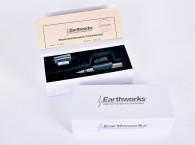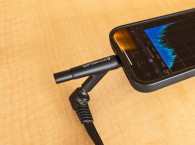
Earthworks, a well-regarded US-based brand, manufactures and markets the M series microphones. For those who are unfamiliar with the company, Earthworks was started by David Blackmer as a measurement microphone company back in the late 1990s before branching out to other markets and developing proprietary acoustics and electronics technology. Blackmer’s goal was to produce the most accurate measurement microphones in the market, since he felt that most of the then-existing products did not give reliable results.
The basic philosophy at Earthworks is optimization of the time-domain response. If the time domain is done well, frequency response will automatically be correct. The inverse is only true for minimum-phase systems, and Earthworks argues that non-minimum phase issues in competitive microphones (e.g., from reflections off grills and other internal structures) are not accounted for. According to Taoufiq Bellamine, Senior Design Engineer at Earthworks, “Everything starts with the understanding of the acoustic impulse response of the microphone, which no other microphone company to this day tests for. All major companies are still set in their ways to focus on the magnitude frequency response alone, which is only half the picture. You need to combine the magnitude and phase responses, to get an impulse response, which is the only accurate test for the true time response of the microphone.”

The Product
The M50 under review here ($1,299 retail price) is the top entry of the M series, which mainly differ in high-frequency cutoff between models (see Photo 1). The capsule used in the M series is an electret with a plastic diaphragm. In general, plastic diaphragms can be lighter and less expensive than metal diaphragms, but have greater variation in properties with changes in temperature and humidity. As with all engineering, it’s a tradeoff. The capsule diameter is 5.8 mm. This is also a tradeoff, this time between noise (smaller capsules are noisier) and polar pattern (larger capsules are more directional). All M series microphones are omnidirectional (free-field) and use the same electret capsule (see Photo 2). The microphones operate off 48 V phantom power and require 10 mA of current.
Because the capsules are the same, the maximum sound pressure level (SPL) and sensitivity remains the same for the entire M series. The “50” in the M50 denotes response flat to 50 kHz; not surprisingly, the M23 is flat to 23 kHz, and the M30 is flat to 30 kHz. The high-frequency cutoff difference is determined by a tuning process.
On the electronics end, Earthworks uses a low noise filter to flatten out any resonances in the capsule and extend the response to high frequencies. They also do an acoustical tuning by adjusting tip geometry — introducing washers, capsule support inner stocks, and other mechanical tweaks. The mechanical design avoids having large cavities that might cause any reflection issues (non-minimum phase) or resonances inside the capsule housing. An M30 (with a 30 kHz cutoff), for example, can be tuned more quickly than an M50, which is reflected in the price differences. Further, to extend response to 50 kHz flat, they use a different ultrasonic stimulus and apparatus for the M50, based on a spark method.
Earthworks uses the sparker apparatus in order to provide a single, very fast, high-energy acoustic spark that simulates an ideal impulse. It can exercise the microphone’s entire frequency range and show any issues with the mechanical construction or electronics. Taoufiq says, “I personally have a locker of all the high end measurement microphones you can think of, and when we expose them to an acoustic spark, we can see some excess ringing and phase issues, not only because of their large diaphragm construction but also because of all the external grills used in them. These issues cannot be seen on a frequency chart alone.”

Although some microphone companies use electrostatic actuators for calibration purposes, at least at higher frequencies, Earthworks does the calibration using acoustic signals, which it claims is an advantage of its approach. In a sense, a bug becomes a feature. Electrostatic actuators do not work properly on plastic diaphragms, but are usually used for metal diaphragms. In any case, the use of acoustic sources for calibration is documented in the IEC 61094-8 standard, and this standard is the basis of how I check microphone calibrations in my home lab.
As later determined, the correspondence between Earthworks’ calibration method and mine is quite good. The microphone itself is finished in attractive brushed steel, and packaged in a padded case along with a mounting clip, foam wind screen, and a 0.25” calibration adapter (see Photo 3). An individual, serialized calibration sheet is included, and the calibration data may be electronically obtained at no charge when the microphone is registered online.
Measurements
Unless otherwise noted, all measurements were performed using an Audio Precision APx515 analyzer and the companion APx1701 transducer interface. I measured frequency response by comparison to a NIST-traceable reference microphone using the same acoustic source (a small full-range speaker flush-mounted in a large absorbent planar baffle) and carefully duplicating the mic position. I do not have an IEC-grade anechoic chamber, but a section of my basement with heavy wall and floor coverings, in conjunction with gating (that is, cutting off the time domain impulse response just before the first major reflection) gives me data very consistent with proper IEC measurements. Gating the impulse response before the first reflections (quasi-anechoic) limits low frequency data, so I show response only above 1 kHz.

The acoustic source outputs little energy above about 30 kHz. So on the high end, my data cut off at that frequency because of the uncertainty. Nonetheless, the response was quite extended to the limits of what I could measure. The frequency response, shown in Figure 1, is within 0.6 dB of the calibration data supplied by Earthworks and is reasonably flat, even before applying correction. This is a very good result and confirms that the M50 conforms to the frequency response limits of Class 1 under IEC 61672, at least at normal room temperature (my lab is about 21°C).
At higher frequencies, increased temperature could have a significant effect. To check the sensitivity, I used a Bruel & Kjaer 4231 calibrator with the 0.25” adapter supplied by Earthworks. The calibrator was set to at 94 dB ref 20 μPa, and a 1 kHz excitation frequency. I measured 36.5 mV output from the microphone, almost exactly the number supplied in Earthworks’ calibration data (36.0 mV), well within the error limits of the calibrator and Earthworks’ measurement.

Figure 2 shows the polar pattern data at 1 kHz and 5 kHz and were taken at 90 dB SPL. The microphone is nearly omnidirectional at lower frequencies, with increasing directionality at higher frequencies because of the microphone geometry. Nonetheless, at 5 kHz, the rear sensitivity is only 3 dB lower than the front sensitivity. This good performance is largely attributable to the small diaphragm and mechanical design of the housing.
Noise level is specified as 22 dB, A-weighted, 20 kHz bandwidth. I measured the noise using my Basement Lab Acoustic Noise Killer (BLANK) setup. This basically involves wrapping the microphone in a plastic bag, wrapping the bag in duct tape to seal it, then burying the wrapped package in about 200 lbs of a mixture of sand and kitty litter in a plastic tub sited on a concrete cellar floor. The tub is covered with thick blankets, and the microphone cable is isolated from any hard surfaces with wadded rags.
This setup, though seemingly crude, effectively enables noise to be measured below 5 dB SPL A-weighted without using a special isolated anechoic chamber. Next, I measured the noise of the M50 to be 23.1 dB SPL A-weighted, slightly higher than the 22 dB SPL A-weighted specification, but reasonably close. This is relatively low noise for a 0.25” capsule and entirely satisfactory for loudspeaker measurement and front-of-house equalization measurement, but a bit higher than you would want for recording. Earthworks has other microphones available for that application, which have significantly lower noise—though they may be less suitable for metrology.
One should be cautious when comparing distortion data measured acoustically with specifications from some manufacturers. I’ve noticed in the fine print of some spec sheets that the manufacturer bypassed the capsule completely and the reported distortion numbers were actually from the electronics alone. This obviously does not give a true picture of distortion as the microphone is intended to be used, but can be useful in specification wars for marketing purposes! With this in mind, I only measure microphone distortion acoustically.

Figure 3 shows the distortion vs. SPL. This was obtained using a 6” loudspeaker driver measured near field (about 2 mm distance to the microphone from the cone), with an amplitude-swept sine wave. The measurement frequency was 1 kHz, though lowering or raising the frequency by a factor of two had no effect on measured distortion. My test limit was 130 dB SPL due to threats of divorce—at that level, distortion measured about 0.93%. Using one of my reference microphones, I confirmed that the distortion of the source was under 0.3%, so the measured distortion here really is that of the microphone.

Figure 4 shows the distortion spectrum of the M50 at 120 dB SPL and 1 kHz. The second and third harmonic dominate, but there is a spray of higher order products as well, though these are low enough in level that they would be unlikely to affect most measurements. If you extrapolate the curve, the 3% distortion point would be expected to be at about 140 dB SPL, which is the specified acoustic limit for the M50.
Wrap-Up
The M50’s measurement s confirm the manufacturer’s claims —moderately low noise, accurate sound pressure measurement, even and extended frequency response, and a good omnidirectional polar pattern. There are competitive microphones that do better in one or two of these areas, but there are none that I’m aware of that offer this particular balance of virtues. For a small test lab, sound reinforcement engineer, or serious loudspeaker designer, this is a compelling product. ax
M50 Omnidirectional Measurement Microphone
Earthworks Audio
37 Wilton Rd.
Milford, NH 03055
info@earthworksaudio.com
www.earthworksaudio.com
Resources
A. Khenkin, “How Earthworks Measures Microphones,” Earthworks Audio,
http://www.earthworksaudio.com/wp-content/uploads/2012/07/how-earthworks-measures-mics.pdf
C. Walber, et al., “Acoustic Methods of Microphone Calibration,” 22nd International Congress on Sound and Vibration (ICSV22), July 2015, www.iiav.org/archives_icsv_last/2015_icsv22/content/papers/papers/full_paper_31_20150330172237431.pdf.
“Earthworks M50 Data Sheet,” Earthworks Audio, www.earthworksaudio.com/wp-content/uploads/2016/08/M50-Data-Sheet-2016.pdf.
This article was originally published in audioXpress, July 2017.







